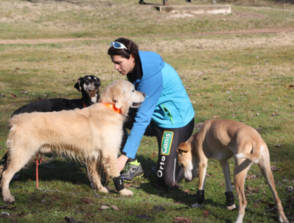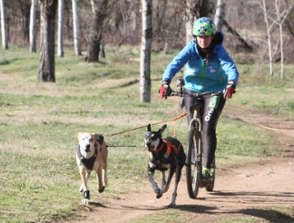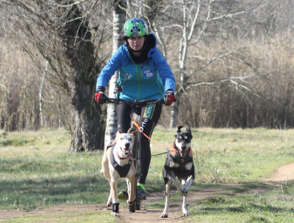Mushing, the sport of huskies, started during the gold fever in Alaska and Canada when dogs were used to transport medicine and people.
 There are different types of mushing depending on the type of terrain where it is practiced, snow or land. In the snow, among the most well known are the sleigh, the Pulka or the Skijoring types, while on land the Quads, Tricycle, Bikejoring and Canicross are the types of mushing practiced.
There are different types of mushing depending on the type of terrain where it is practiced, snow or land. In the snow, among the most well known are the sleigh, the Pulka or the Skijoring types, while on land the Quads, Tricycle, Bikejoring and Canicross are the types of mushing practiced.
In all these disciplines the protagonists are the dogs and for the mushers and handlers the dogs are the priority and are most important. As such they spend much of their time caring for them. Among the most commonly used breeds for this pulling sport are Huskies, Malamutes, Samoyeds and Greenlanders, though in recent years there have been crosses with hound dogs in order to increase speed and endurance; from these crosses the Alaskans were born .
.
Within the different disciplines, physiotherapy plays a very important role by responding to the problems and injuries that accompany this practice, especially at the musculoskeletal level. The most common problems to arise are swelling of the wrists, plantar injuries, hip problems, bruising, stretching, distensions, contractures, muscular tensions (overload), tendinopathies, fibrillar breakage, joint locking and, to a less extent, injuries of the brachial plexus especially in those dogs that run in snow.
 The physiotherapist should know how to use the different techniques (massage, manipulative techniques, mobilizations, analytical and comprehensive stretching, cryotherapy, functional and proprioceptive bandages, thermotherapy, electrotherapy, proprioceptive techniques, etc.), although the physical therapist’s priority with these superathletes is to try and prevent these injuries from occurring by carrying out personalized exercises for each animal that should be done both during the trainings and in competitions.
The physiotherapist should know how to use the different techniques (massage, manipulative techniques, mobilizations, analytical and comprehensive stretching, cryotherapy, functional and proprioceptive bandages, thermotherapy, electrotherapy, proprioceptive techniques, etc.), although the physical therapist’s priority with these superathletes is to try and prevent these injuries from occurring by carrying out personalized exercises for each animal that should be done both during the trainings and in competitions.
To avoid injuries it is very important that the animal uses the appropriate material. It is necessary to use a collar that does not punish or strangulate the animal as well as a special harness for practicing this sport that gives the dog freedom without harming them. There are three types of harnesses: in X, which are the most commonly used, in H, which are more appropriate for long distances, and dragging harnesses for carrying heavy loads. Boots are also necessary for protecting the footpads and lastly thermal blankets are used in extreme cold, or when removing an animal and putting it on the sled as a way of preventing hypothermia.
Animal Physical Therapist
Collaborator Ortocanis.com

